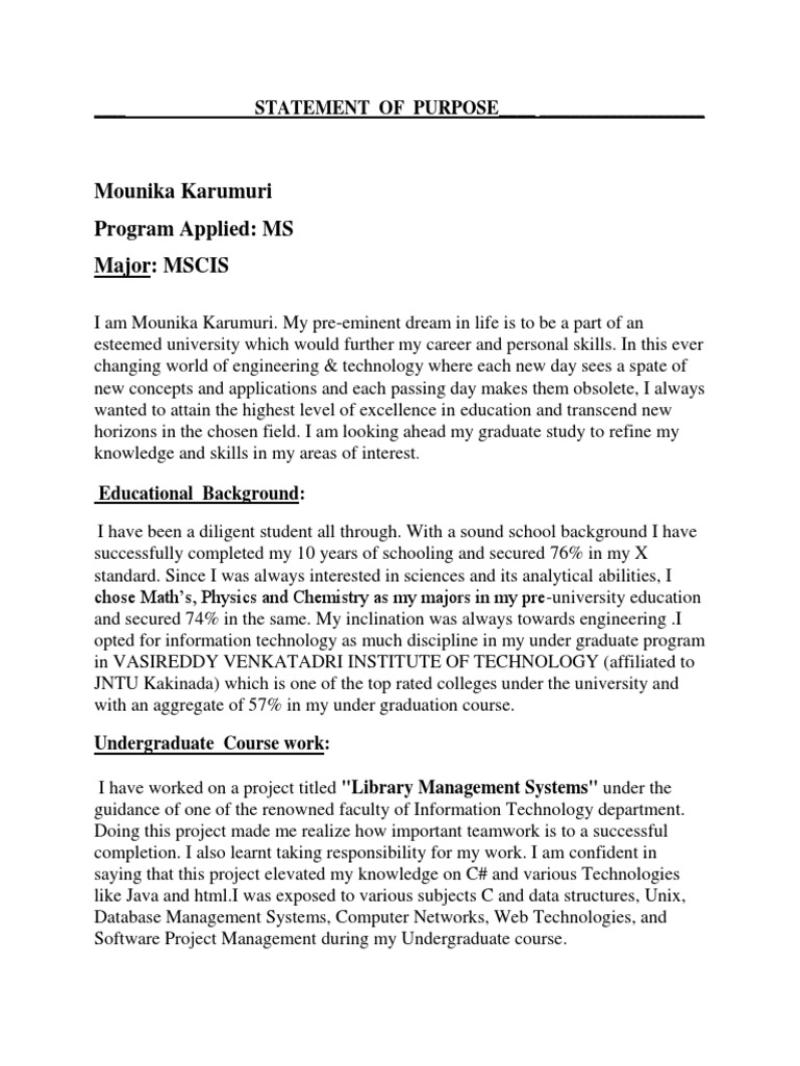What is the general format for SOP?
The Statement of Purpose (SOP) is a crucial document when applying for graduate programs, scholarships, or jobs. It provides an opportunity for applicants to convey their goals, qualifications, and reasons for pursuing a particular opportunity. While the specific requirements may vary, here is a general format for writing an effective SOP:
1. Introduction:
- Personal Introduction:
- Begin with a brief personal introduction, including your name, educational background, and any relevant achievements or experiences.
- Purpose of the SOP:
- Clearly state the purpose of the SOP, indicating the program or opportunity you are applying for.
2. Educational Background:
- Academic History:
- Provide a concise overview of your academic background, including degrees earned, institutions attended, and major subjects.
- Highlight any academic achievements, honors, or awards.
3. Professional Experience (if applicable):
- Work History:
- Detail your relevant work experience, emphasizing positions, responsibilities, and achievements.
- Connect your professional experience to your academic and career goals.
4. Research and Academic Interests:
- Research Interests:
- Clearly articulate your research interests and the specific areas you wish to explore during the program.
- Mention any relevant research projects, publications, or conferences.
5. Career Goals:
- Short-Term and Long-Term Goals:
- Outline your short-term and long-term career goals, explaining how the program aligns with these aspirations.
- Discuss how the skills and knowledge gained will contribute to your career path.
6. Connection to the Program:
- Why this Program?
- Explain why you are interested in the specific program or opportunity.
- Mention faculty members, resources, or unique aspects of the program that attract you.
7. Relevance of Previous Experience:
- Connecting Past Experiences:
- Demonstrate how your educational and professional experiences have prepared you for the program.
- Highlight relevant skills, knowledge, and accomplishments.
8. Contributions to the Program:
- What You Bring to the Program:
- Discuss the unique qualities, perspectives, or skills you bring to the program.
- Explain how you plan to contribute to the academic community.
9. Conclusion:
- Summary and Closing Remarks:
- Summarize key points discussed in the SOP.
- End with a strong closing statement that reinforces your enthusiasm for the program.
10. Language and Style:
- Clarity and Conciseness:
- Write clearly and concisely, avoiding unnecessary jargon.
- Use a formal and professional tone throughout.
11. Length and Formatting:
- Adherence to Guidelines:
- Follow any specific length requirements provided by the institution or organization.
- Adhere to formatting guidelines, including font size and margins.
12. Proofreading:
- Editing and Proofreading:
- Edit and proofread your SOP to eliminate grammatical errors, typos, and inconsistencies.
- Ensure that the document is well-organized and flows logically.
13. Personalization:
- Tailor for Each Application:
- Customize your SOP for each application, addressing specific program features or requirements.
Remember that the SOP is an opportunity to showcase your qualifications and convey a compelling narrative about your academic and professional journey. It should provide insights into your motivations, aspirations, and the value you bring to the program or opportunity. Always check and follow the specific guidelines provided by the institution or organization to which you are applying.
Crafting a compelling Statement of Purpose (SOP) can be your key to unlocking doors to exciting academic and professional opportunities. Let's dive into the structure, content, and tailoring tips to help you craft a standout SOP:
1. General Format:
While specific requirements may vary, a strong SOP typically follows this general format:
- Introduction: Briefly introduce yourself, your background, and your overall goal.
- Academic and Professional Background: Highlight your relevant academic achievements, projects, research experiences, and professional skills.
- Motivation and Aspiration: Explain your specific interest in the program or institution and how it aligns with your long-term career goals.
- Future Plans: Briefly outline your future aspirations and how the program will equip you to achieve them.
- Conclusion: Summarize your key points and reiterate your enthusiasm for the program.
2. Presenting Aspirations:
Structure your presentation around a compelling narrative. Instead of just listing achievements, connect them to your evolving interests and aspirations.
- Demonstrate passion: Show genuine enthusiasm for the field and your desired program.
- Highlight relevant experiences: Connect your academic and professional experiences to your goals, showcasing valuable skills and contributions.
- Quantify achievements: Use data and metrics to quantify your success whenever relevant.
- Personalize your story: Let your unique voice and personality shine through, avoiding generic statements.
3. Content and Tone:
- Content: Focus on specific details and avoid generalizations. Back up your claims with evidence and examples.
- Tone: Maintain a professional, yet conversational tone. Be confident, clear, and concise.
- Proofread and edit: Ensure your SOP is free of grammatical errors and typos.
4. Components and Sections:
- Academic Background: Highlight relevant coursework, GPA, research projects, academic awards.
- Professional Experience: Describe your experience, specific skills gained, and achievements.
- Research Interests: For research-oriented programs, clearly define your research goals and potential contributions.
- Extracurricular Activities: Briefly mention relevant activities that showcase leadership, teamwork, or other valuable skills.
- Recommendation Letters: Secure strong letters of recommendation that complement your SOP.
5. Tailoring to Requirements:
- Research program requirements: Align your research interests and goals with the program's focus and faculty expertise.
- Institutional values: Show how your values and goals resonate with the institution's mission and vision.
- Program-specific prompts: Address any specific questions or prompts provided by the institution.
Remember:
- Stay honest and authentic: Let your genuine passion and experiences shine through.
- Showcase your potential: Focus on what you can offer, not just what you've achieved.
- Proofread and revise: Ensure your SOP is polished and error-free.
By following these tips and tailoring your SOP to each program, you can create a compelling statement that sets you apart and opens doors to a bright future.













